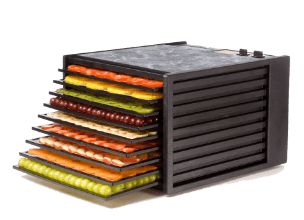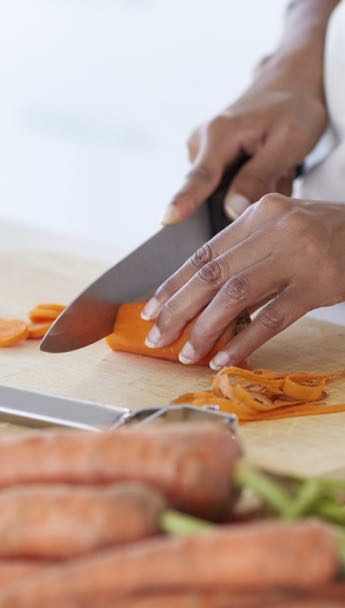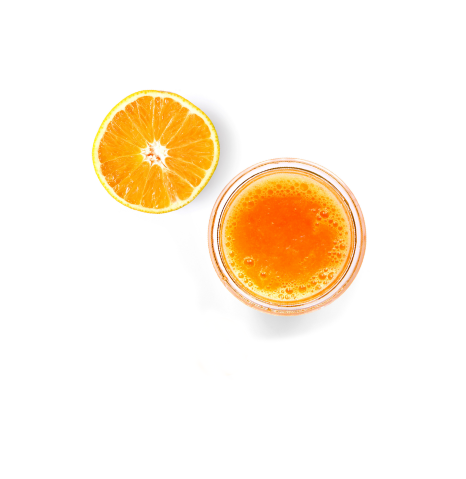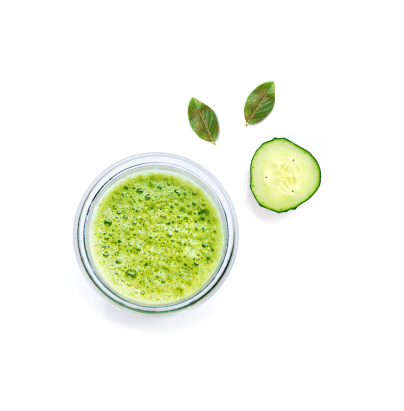Beginners Guide To Spiralizing
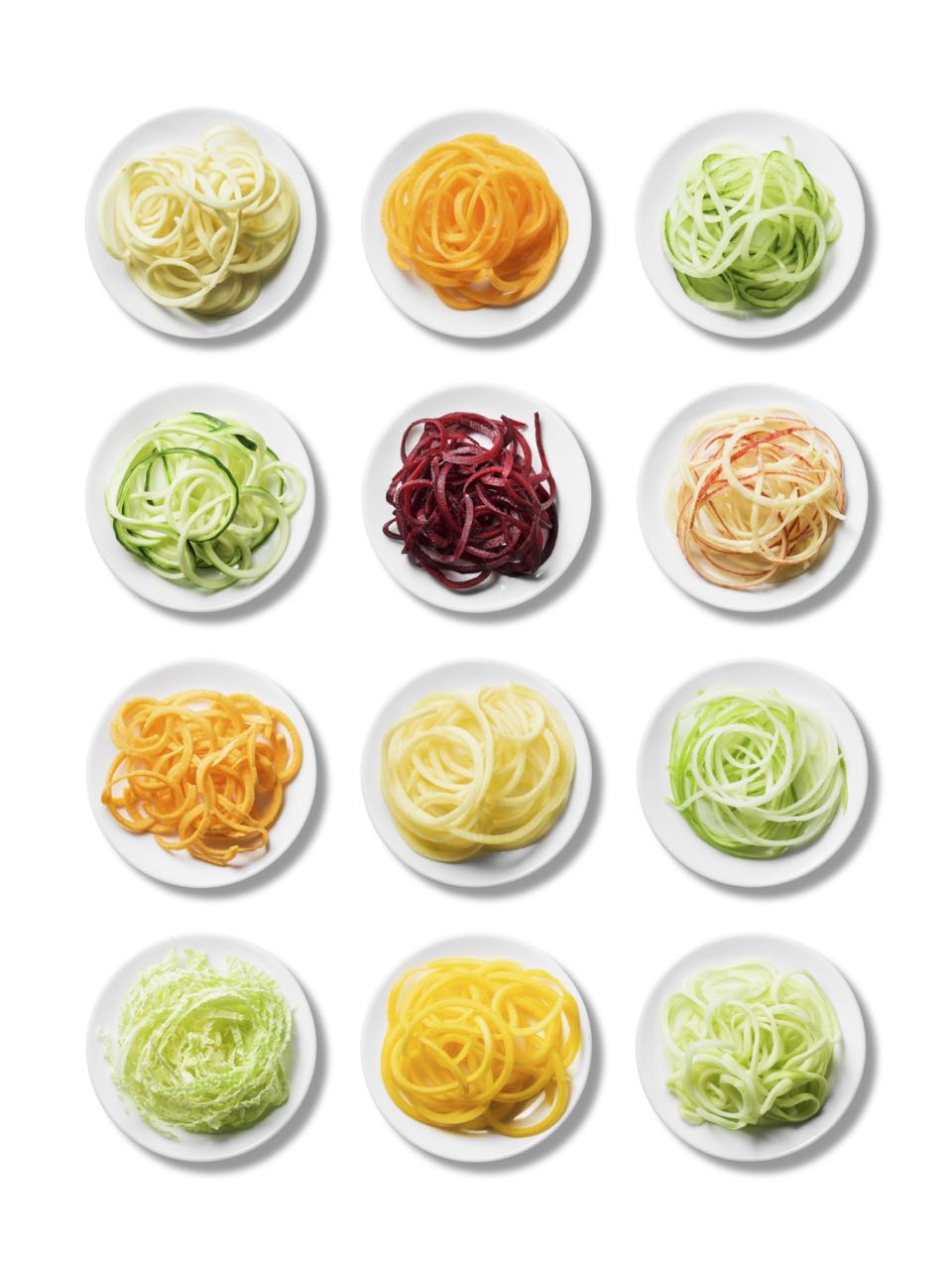
Spiralizing is the art of using a spiralizer to turn vegetables and fruit into oodles of noodles, and are an essential gadget for your kitchen. But if you are asking ‘what is this spiralizing thing all about?’, ‘why is it so popular?’, and ‘how can I join in?’, then we are here to explain all.
If you are unsure as to just why you should be spiralizing, or not sure how to get started, let us be your guide. We will take you through why you should spiralize, how spiralizers work, which models you can use, what fruit and veg you can spiralize, how to cook your spiralized fruit and veg, and beginners recipes for you to have a go at, and discover just how wonderful spiralizing can be.
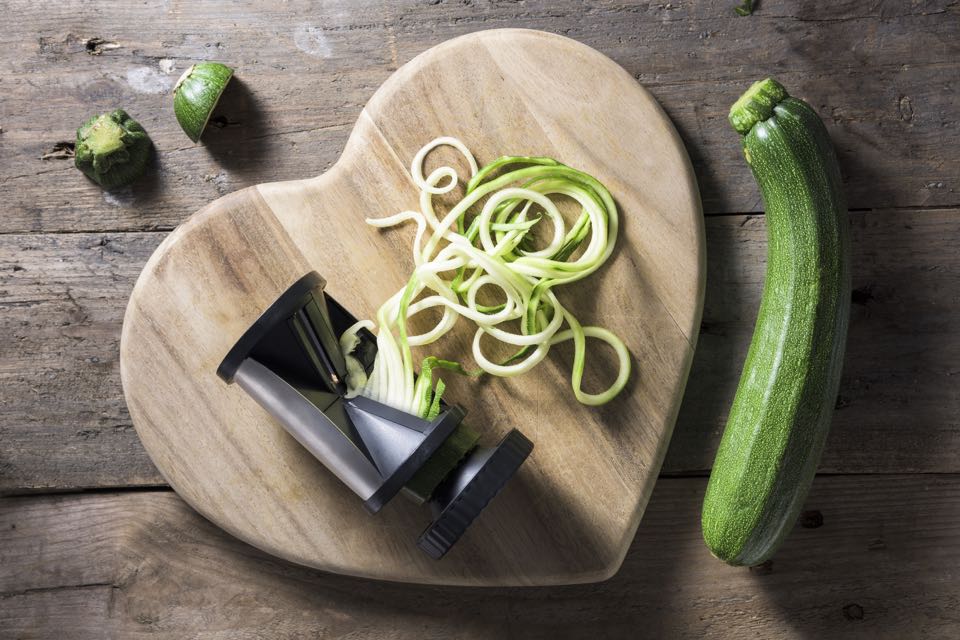
CONTENTS
Why Spiralize?
How Do Spiralizers Work?
Which Spiralizer Should I Use?
What Can You Spiralize?
How Do You Cook Spiralized Foods?
Recipes For Beginners
Why Spiralize?
There are loads of great reasons why you should spiralize whether you want to add variety to a restrictive diet or just eat more fruit and veg spiralizing can help.
Eat More Veg Without Even Realising It – Spiralizing is a great way to pack more fruit and vegetables into your diet, as you can eat your favourite dishes, such as pasta, but with veg instead. In contrast to slicing or dicing, spiralizing also makes more of your veg, as you get loads more spirals than you would slices.
Promotes Health and Weight Loss – Because you’re naturally eating more veg than processed
foods, you’ll eat healthier. This is because spiralized vegetables
are low in calories, fat, sugar and carbohydrates, which all make for
a healthy diet and lifestyle. Eating more vegetables will promote weight loss, you’ll get more fibre to aid digestion, and feel more energised and motivated from all the nutritional benefits of veg and fruit.
Vegan, Paleo, Vegetarian & Gluten Friendly – For those with Celiac’s disease or intolerances to gluten, spiralizing offers a suitable alternative to gluten filled foods such as pasta or rice. Spiralizing utilises vegetables rather than grain based products so is also suitable for vegetarian, vegan and paleo diets.
It’s Great for Kids -Children are much more likely to eat fruit and veg if they are in fun spiral shapes, and you can sneak more onto the plate too. Spiralizing is also fun for children to get involved with, as long as an adult is supervising with the sharp blades. Spiralizing can teach your children how to prepare food and promote healthy eating habits.
It’s Quick and Easy -Spiralizing is a quick and easy way to prepare veg, as most of us can’t dice and chop veg at lightning speeds like professional chefs. The veg also has a shorter cooking time than pasta,
so they’re perfect for busy lifestyles. Spiralizing is also super creative,
as you can invent different ways to prepare, cook and plate up meals, with exciting textures and tastes. The possibilities are almost endless.
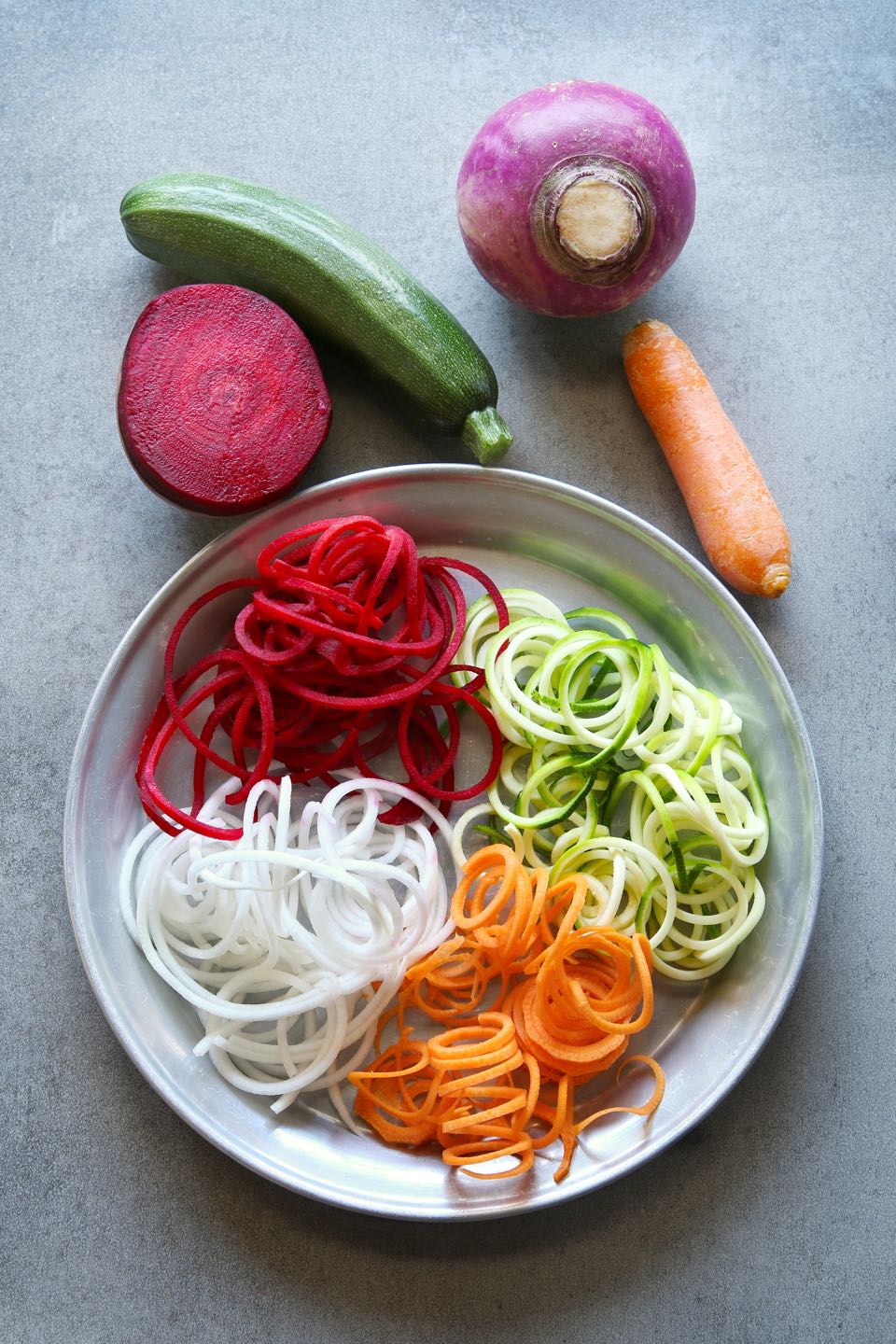
How Do Spiralizers Work?
Spiralizers are incredibly simple to use. Each model of spiralizer does vary slightly in use, but all essentially work in the same way:
- Choose the blade you wish to use and insert into the machine.
- Prepare your vegetable or fruit.
- Hold the fruit or veg in
place using the clamp or spike at one end, and the handle at the other - Turn the handle whilst applying pressure towards the blades, to press the fruit or
vegetable through the blades. - Watch as loads of vegetable and fruit twirls, ribbons and spirals appear through the blades for you to eat and enjoy!
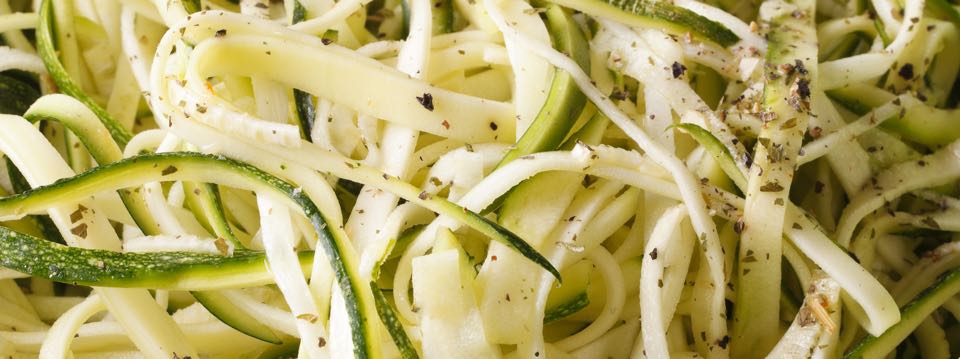
Which Spiralizer Should I Use?
There are many different types of Spiralizer so it can be difficult to know which is the right one for you. But we’re here to help you find your perfect match, because
we know spiralizers inside and out. It’s what we do. We introduced Spiralizers to our range nearly ten years ago, long before courgette spaghetti was even a thing!
When choosing the perfect spiralizer, it’s really a matter of finding a spiralizer to suit your requirements. Take a look at the list below for some of the best spiralizers on the market.
For a more in-depth guide to spiralizers, read our buyer’s guide to determine which is the best spiralizer for you.
Handheld Spiralizers
This is the cheapest option and work just like a pencil sharpener. They’re small enough for on the go spiralizing but you may not want to prepare a family meal this way.
Try the Gefu Spirelli 2.0 Spiral Slicer which cuts vegetables up to 6cm diameter and is dishwasher safe

Maybe you’re the traditional nononsense kind, and prefer the classic Julienne Slicer.
This gadget looks like your average vegetable peeler, but in fact creates thin, evenly sized strips.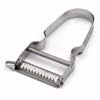
Horizontal Spiralizers
These can spiralize larger fruit and vegetables than the handheld gadgets although it will leave a core. They do however manage much larger diameter veg than handheld or vertical models and a large amount of vegetables can be spiralized in a short time.
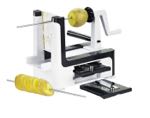 For super spiralizing, the Lurch Super Spiralizer slices all sorts of fruit and veg into ribbons with
For super spiralizing, the Lurch Super Spiralizer slices all sorts of fruit and veg into ribbons with
its 2mm and 5mm blades. Unlike other horizontal models, it holds fruit and veg in place using a skewer to cut down on waste. What’s more, it’s held firmly in place through suction feet as you process the ingredients, so it can’t slip away from you.
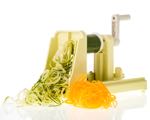 Have a look at the Chiba Kaiten Japanese Spiralizer, which comes with 3 blades for different sized ribbons, it’s super easy to clean and even easier to use with its handy autofeed function, so you can let it do all the hard work for you. This is probably the easiest to use of all the spiralizers out there.
Have a look at the Chiba Kaiten Japanese Spiralizer, which comes with 3 blades for different sized ribbons, it’s super easy to clean and even easier to use with its handy autofeed function, so you can let it do all the hard work for you. This is probably the easiest to use of all the spiralizers out there.
Vertical Spiralizers
Vertical Spiralizers generally take a slightly smaller diameter and shorter length than their horizontal buddies. They do however leave no wastage because no core is cut, and a spike holds the veg in place instead. This also makes the fruit or vegetable less likely to fall out of place, and downward pressure is instead applied so that it can work faster.
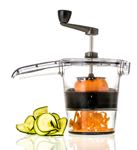 The Gefu Spiralfix Spiralizer, comes with its own self-contained base which doubles as a sealable container. Its handle makes for easy and sturdy spiralizing, and you don’t even have to change blades for different cuts, as it has a rotating blade that you can turn and lock to switch shapes.
The Gefu Spiralfix Spiralizer, comes with its own self-contained base which doubles as a sealable container. Its handle makes for easy and sturdy spiralizing, and you don’t even have to change blades for different cuts, as it has a rotating blade that you can turn and lock to switch shapes.
 The Benriner Turning Slicer (Vertical) produces the best 1mm thick slices and angel hair noodles. It’s incredibly compact, and contains heavy duty and high quality blades. Japanese engineering at its finest.
The Benriner Turning Slicer (Vertical) produces the best 1mm thick slices and angel hair noodles. It’s incredibly compact, and contains heavy duty and high quality blades. Japanese engineering at its finest.
What Can You Spiralize?
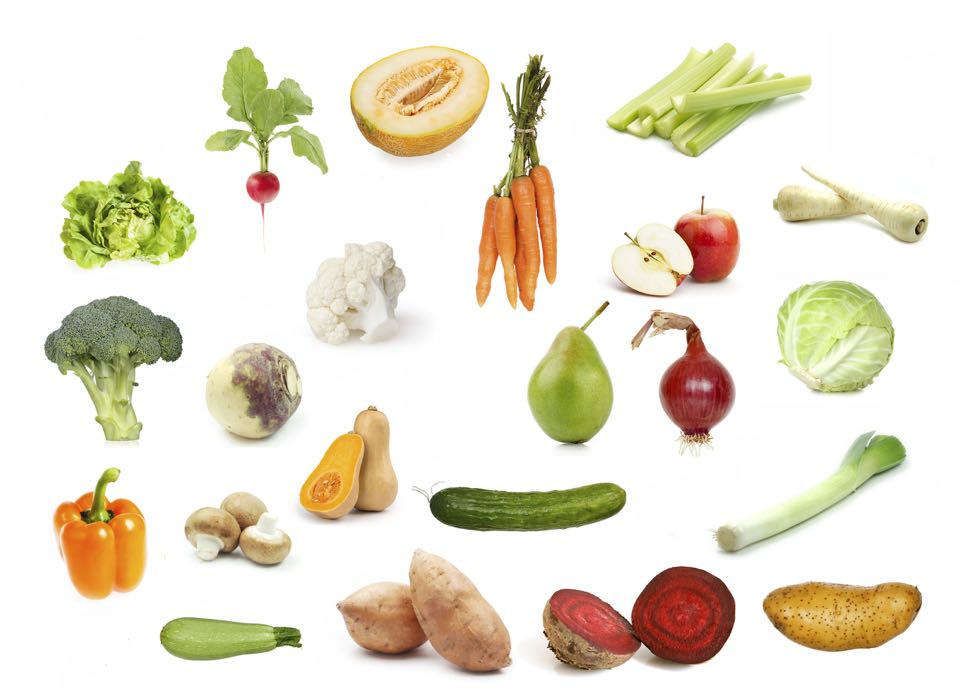
A wide variety of fruits and vegetables can be spiralized. If your ingredient is firm and solid, not too juicy, hollow or seeded, then it was destined to be spiralized. But you can even make spaghetti or noodle shapes out of some softer ingredients like peppers and cucumbers for salads if you like. Veg needs to be cut to fit the size of the spiralizer you are using. Here’s a list of the most commonly spiralized ingredients:
Courgettes – the vegetable that brought fame to the art of spiralizing through the delicious medium of Courgette Spaghetti or ‘Courgetti’. The Americans call these Zucchini and they prefer the name ‘Zoodles’ to Courgetti
Potatoes – make curly fries or spirals to jazz up your cooked meals, or you can wrap a potato noodle spiral blanket around fresh prawns for sautéing to create a tasty crispy casing around them
Sweet Potatoes – use these in the same way as the simple spud for a change of colour, texture and flavour
Carrots – great for making fine noodles for salads and stir fries
Daikon Radish or Mooli – these long white radish are a Japanese favourite for garnishes, add to salads as fine spiralized noodles or even pickle them raw in a rice vinegar marinade
Beetroot – roasted spiral slices are a firm favourite of ours along with beetroot noodles mixed with other hard veg spaghetti in a nice tangy salad dressing
Apples – spiralizing apples or other firm fleshed fruits is a great way to add texture to salads or to make an enticing baked dessert
Cucumber – great for simple spiral fronds for your salads
Butternut Squash – roasted butternut squash noodles are to die for. Also works for other firm squash
… the list is long but this is a beginners guide and with our downloadable recipe leaflet (and one of our fantastic spiralizers!) you’ll have all you need to get started. For more advanced spiralizing graduates we highly recommend a copy of ‘Inspiralized‘ by Ali Maffucci.
How Do You Cook Spiralized Foods?
Spiralized fruit and vegetables can be cooked and eaten in the same way as you’d enjoy regularly sliced fruit and veg. The best cooking methods for spiralized fruit and vegetables are steam, sauté, boil, bake/roast, simmer, stir-fry or simply raw.
Steam
This method works well for harder veg like carrots and celeriac and only takes a couple of minutes.
Sauté
Sautéeing can be used to cook all vegetable noodles. Add the noodles to a pan with oil, and
sauté. Root vegetables will take longer to cook than softer vegetables.
Roast
Spiralized carrots, parsnips, celeriac, turnip, butternut and pear are ideal for roasting. Place on a baking tray in the oven and roast for approx 10 minutes.
Simmer
Add raw noodles such as courgette into a simmering sauce to cook.
Stir Fry
Stirfry vegetables such as onions, cabbage and pepper in a saucepan or wok.
Boil
This is suitable for most harder vegetables including white potato, courgette and carrot, however, sweet potatoes and butternut squash tend to disintegrate when boiled. We don’t recommend too much boiling and for many ingredients just a quick blanching in boiling water will leave more nutrients intact. Blanched hard veg lend themselves to other methods like sautéeing, marinating in dressings or pickling
Raw
Most veg and fruit retain more nutrients when left raw. Enjoy veg such as cucumber and beetroot this way to spice up your salads!
Experiment!
We will often steam our spiralized vegetables and then quickly saute them
in a pan with some butter or olive to nish them off perfectly. The key here is to experiment and see how you prefer your spiralized fruit and veg!
Spiralizer Recipes For Beginners
The recipes in our free booklet serve as a starting point to breaking in your spiralizer and testing out some simple and easy to follow recipes. Once you have mastered the art of spiralizing, you’ll be able to experiment with some of your own recipes, the different fruit and veg you can use, and the various methods you can cook with. You can either click on the link below and download via you browser controls, or right click (two finger click on a mac) and select “save link as” to get your copy.
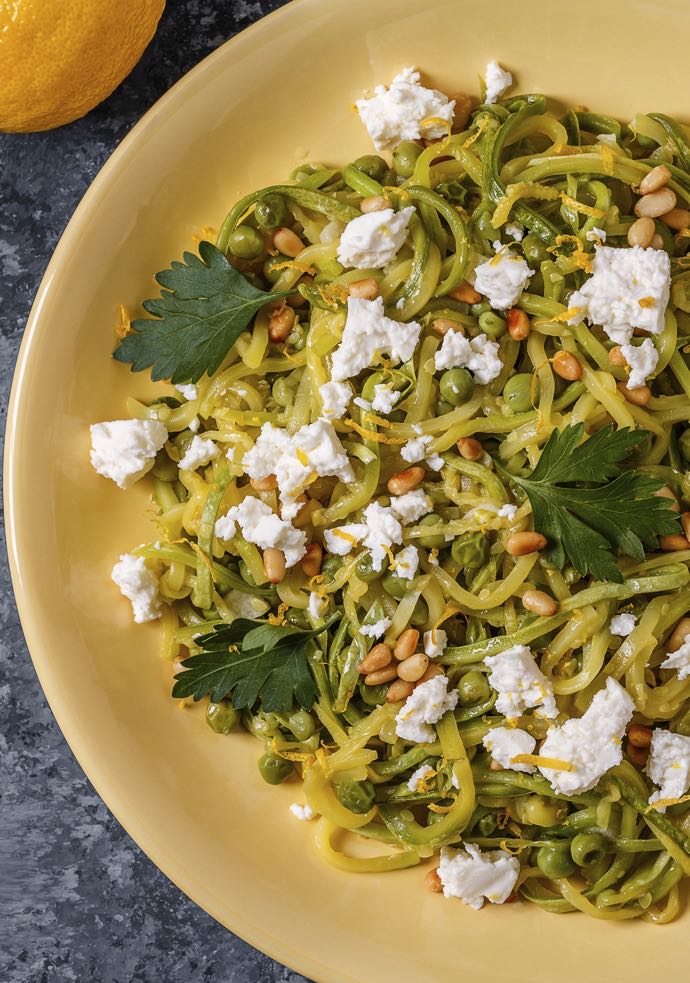
 Register / Login
Register / Login 





